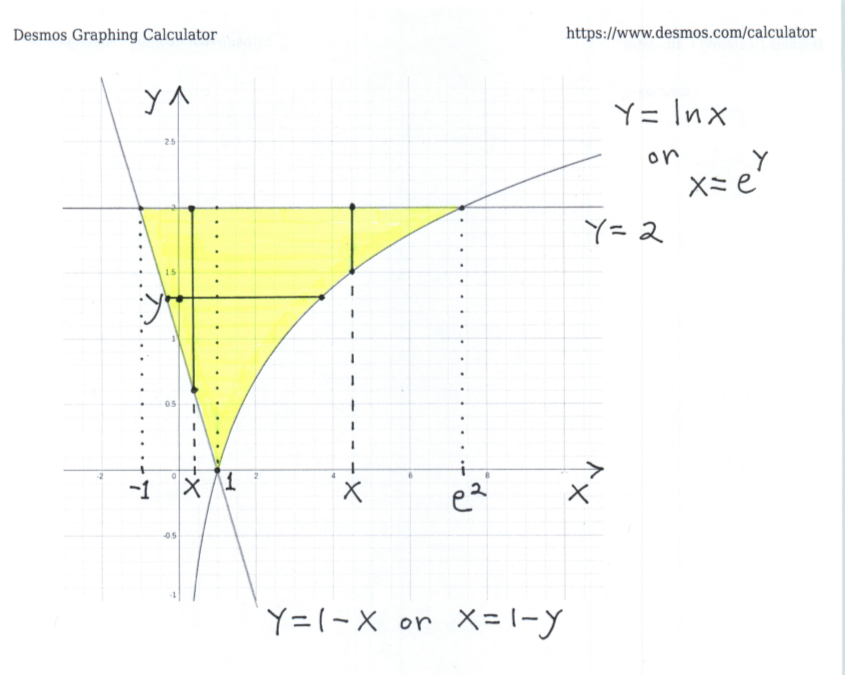SOLUTION 27: Compute the area of the region enclosed by the graphs of the equations $ y= \ln x \ \ (or \ \ x=e^y)$,
$ y= 1-x \ \ (or \ \ x= 1-y) $, and $y=2$ . Begin by finding the points of intersection of the the three graphs.
From $ y= \ln x $ and $ y= 1-x $ we get that
$$ x=1 $$
From $ y=1-x $ and $ y=2 $ we get that
$$ 1-x = 2 \ \ \longrightarrow \ \ x=-1 $$
From $ y= \ln x $ and $ y=2 $ we get that
$$ \ln x = 2 \ \ \longrightarrow \ \ x=e^2 $$
Now see the given graph of the enclosed region.

a.) Using vertical cross-sections to describe this region, which is made up of two smaller regions, we get that
$$ -1 \le x \le 1 \ \ and \ \ 1-x \le y \le 2 \ $$
in addition to
$$ 1 \le x \le e^2 \ \ and \ \ \ln x \le y \le 2 \ , $$
so that the area of this region is
$$ AREA = \displaystyle{ \int_{-1}^{1} ( Top \ - \ Bottom ) \ dx + \int_{1}^{e^2} ( Top \ - \ Bottom ) \ dx } $$
$$ = \displaystyle{ \int_{-1}^{1} ( 2 - (1-x) ) \ dx + \int_{1}^{e^2} ( 2 - \ln x ) \ dx } $$
$$ = \displaystyle{ \int_{-1}^{1} ( 1+x ) \ dx + \int_{1}^{e^2} ( 2 - \ln x ) \ dx } $$
$ \Big( $ Recall that (See the solution to problem 26 using integration by parts) $ \displaystyle{ \int \ln x \ dx } = \displaystyle{ x \ln x - x + C } $. $ \Big) $
$$ \displaystyle { = ( x + (1/2)x^2 ) \Big\vert_{-1}^{1} + ( 2x -( x \ln x -x ) ) \Big\vert_{1}^{e^2} } $$
$$ \displaystyle { = ( x + (1/2)x^2 ) \Big\vert_{-1}^{1} + ( 3x - x \ln x ) \Big\vert_{1}^{e^2} } $$
$$ \displaystyle { = \Big( ( 1+1/2 ) - ( -1+1/2 ) \Big) + \Big( ( 3e^2-e^2\ln e^2 ) - ( 3 - \ln 1 ) \Big) } $$
$ \Big( $ Recall that $ \displaystyle{ \ln e^k = k } $ and $ \ln 1 =0 $. $ \Big) $
$$ \displaystyle { = 2 + 3e^2 -e^2 (2) - 3 + 0 } $$
$$ \displaystyle { = e^2 -1 } $$
b.) Using horizontal cross-sections to describe this region, which is made up of two smaller regions, we get that
$$ 0 \le y \le 2 \ \ and \ \ 1-y \le x \le e^y \ , $$
so that the area of this region is
$$ AREA = \displaystyle{ \int_{0}^{2} ( Right \ - \ Left ) \ dy } $$
$$ = \displaystyle{ \int_{0}^{2} (e^y - (1-y)) ) \ dy } $$
$$ = \displaystyle{ \int_{0}^{2} (e^y - 1 + y ) \ dy } $$
$ \Big( $ Recall that $ \displaystyle{ \int e^z \ dy = e^z + C } $. $ \Big) $
$$ \displaystyle{ = \Big( e^y-y+(1/2)y^2 \Big) \Big\vert_{0}^{2} } $$
$$ = \Big( e^2-2+(1/2)(2)^2 \Big) - \Big( e^0-0+(1/2)(0)^2 \Big) $$
$$ = e^{2} - 2 + 2 -1 $$
$$ = e^{2} -1 $$
Click HERE to return to the list of problems.

